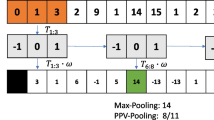Abstract
A novel neural-network-based method of time series forecasting is presented in this paper. The method combines the optimal partition algorithm (OPA) with the radial basis function (RBF) neural network. OPA for ordered samples is used to perform the clustering for the samples. The centers and widths of the RBF neural network are determined based on the clustering. The difference of the objective functions of the clustering is used to adjust the structure of the neural network dynamically. Thus, the number of the hidden nodes is selected adaptively. The method is applied to stock price prediction. The results of numerical simulations demonstrate the effectiveness of the method. Comparisons with the hard c-means (HCM) algorithm show that the proposed OPA method possesses obvious advantages in the precision of forecasting, generalization, and forecasting trends. Simulations also show that the OPA–orthogonal least squares (OPA–OLS) algorithm, which combines OPA with the OLS algorithm, results in better performance for forecasting trends.









Similar content being viewed by others
References
Qi M, Zhang GP (2001) An investigation of model selection criteria for neural network time series forecasting. Eur J Operat Res 132(3):666–680
Liang YC, Wang Z, Zhou CG (1998) Application of fuzzy neural networks to the prediction of time series. Comput Res Dev 7:661–665
Cao LJ, Tay Francis EH (2001) Financial forecasting using support vector machines. Neural Comput Appl 10(2):184–192
Swingler K (1996) Financial prediction: some pointers, pitfalls and common errors. Neural Comput Appl 4(4):192–197
Burrell PR, Folarin BO (1997) The impact of neural networks in finance. Neural Comput Appl 6(4):193–200
Van Gestel T, Suykens JAK, Baestaens DE, Lambrechts A, Lanckriet G, Vandaele B, De Moor B, Vandewalle J (2001) Financial time series prediction using least squares support vector machines within the evidence framework. IEEE Trans Neural Netw 12(4):809–821
Sitte R, Sitte J (2000) Analysis of the predictive ability of time delay neural networks applied to the S&P 500 time series. IEEE Trans Syst Cybern Part C Appl Rev 30(4):568–572
Virili F, Freisleben B (2001) Neural network model selection for financial time series prediction. Comput Stat 16(3):451–463
Dorsey R, Sexton R (1998) The use of parsimonious neural networks for forecasting financial time series. J Comput Intell Finance 6(1):24–31
Tay Francis EH, Cao LJ (2001) Application of support vector machines in financial time series forecasting. Int J Manag Sci 29(4):309–317
Tay Francis EH, Cao LJ (2002) ɛ-descending support vector machines for financial time series forecasting. Neural Processing Lett 15(2):179–195
Haykin S (1999) Neural networks: a comprehensive foundation. Prentice-Hall, Englewood Cliffs, New Jersey
Fang KT (1989) Practical multivariate statistic analysis. East China Normal University Press, Shanghai
Spath H (1980) Cluster analysis algorithms for data reduction and classification of objects. Halsted Press, New York
Dillon WR, Goldstein M (1984) Multivariate analysis: methods and applications. Wiley, New York
Thomason M (1999) A basic neural network-based trading system: project revisited (parts 1 and 2). J Comput Intell Finance 7(3):36–45
Thomason M (1999) A basic neural network-based trading system: project revisited (parts 3 and 4). J Comput Intell Finance 7(4):35–45
Sergios T, Konstantinos K (2003) Pattern recognition, 2nd edn. Elsevier, Amsterdam, The Netherlands
Chen S, Cowan CFN, Grant PM (1991) Orthogonal least-squares learning algorithm for radial basis function networks. IEEE Trans Neural Netw 2(2):302–309
Chen S (2002) Multi-output regression using a locally regularised orthogonal least-squares algorithm. IEEE Proc Vis Image Signal Processing 149(4):185–195
Chen S, Hong X, Harris CJ (2003) Sparse multioutput radial basis function network construction using combined locally regularised orthogonal least square and D-optimality experimental design. IEE Proc Control Theory Appl 150(2):139–146
Wu KL, Yang MS (2002) Alternative c-means clustering algorithms. Pattern Recognit 35(10):2267–2278
Acknowledgements
The first two authors are grateful to the support of the NSFC.
Author information
Authors and Affiliations
Corresponding author
Rights and permissions
About this article
Cite this article
Sun, Y.F., Liang, Y.C., Zhang, W.L. et al. Optimal partition algorithm of the RBF neural network and its application to financial time series forecasting. Neural Comput & Applic 14, 36–44 (2005). https://doi.org/10.1007/s00521-004-0439-7
Received:
Accepted:
Published:
Issue Date:
DOI: https://doi.org/10.1007/s00521-004-0439-7




